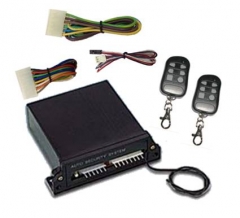=== RF Remote Control Series by AutoMicro ===
RF Remote Control Subsystem

This is a RF remote control subsystem with 6-button rolling code transmitter and 6 relays built inside the system. It’s the active low type. Major applications are for the garage opener, trunk release or lighting remote control. You can also use it as a general-purpose remote control system to control many applications around your home or for other hobby projects. You can add up to 15 transmitters per system.
The activated relay will be closed until you push the button again. You can use it to control a 110V or 220V AC lamp or appliance by connecting through a suitable external strong AC-relay first. Push the transmitter’s button to turn the lamp or the appliance on. Repress the button will turn it off.
=== Solar Charge Controller by PowerMaster ===
PM-SCC-30AP-1248

Description:
The world’s leading solar charge controller for both professional and consumer applications.
3 Stage pulse width modulated charge control.
Character:
Battery charging, load control or diversion regulation.
Highest reliability – large heat sink and conservative design enables operating at full ratings to 45°C.
More information – Internal and optional meter displays extensive system and controller information, automatic self-test and reset.
Displays can be in multi-languages.
Communications capability – RS-422 connects to a personal computer for custom settings, data logging and remote monitoring and control. (LCD meter is option)
Fully adjustable – DIP switch provides user with choice of 7 digital presets.
Additional custom settings via RS-422.
Extensive electronic protections – Fully protected against reverse polarity, short circuit, overcurrent, high temperature and overvoltage.
=== Touch Panel by Elcom Design ===
Capacitive Touch Screens

A touch panel is an input device that is commonly placed in front of the display screens of instruments which require human interface. it is often used to enhance or supplement the more traditional input technologies such as membrane or silicone-rubber keys. And because of the intuitive nature of touch screens, this method has been gaining popularity over the years. Elcom Design touch panels are designed and manufactured to meet the highest level of standards, so customers are assured of reliable quality and consistent assembly schedules all the time.
Capacitive Touch Screens are all-glass panels with a transparent metallic conductive coating. electrode pattern printed along the edges which distributes a low voltage field over the conductive layer. So when a finger touches the screen and draws a minute amount of current to the point of contact, it creating a voltage drop. This current flow from each corner that is proportional to the distance of the touch point allows the location of the point of contact to be calculated by the controller.
Capacitive touch screens are much different than resistive touch screens in the way that they function. These screens are coated with those stores electrical charges. The coating is typically indium tin oxide, which allows the capacitive touch screen to continuality carry an electrical charge.



